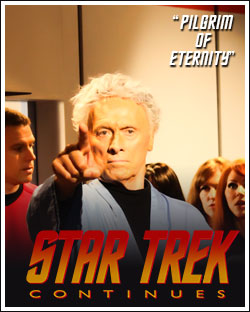 Star Trek Continues – “Pilgrim of Eternity”
Star Trek Continues – “Pilgrim of Eternity”




Directed by Vic Mignogna
Written by Steve Fratt and Jack Trevino
Story by Vic Mignogna and Jack Marshall
Starring Vic Mignogna, Todd Haberkorn, Larry Nemeck, Chris Doohan, Grant Imahara, and featuring Michael Forrest
Rating: This series is suitable for all-ages.
As a bit of a disclaimer, I was never really into the Star Trek franchise as a young geek. The Original Series was long gone before I was born, and since my parents aren’t into fiction that strays too far from reality, I didn’t watch “Star Trek: The Next Generation” with my parents, like many of my fellow geeks did with theirs. Therefore, when I heard that anime voice actor Vic Mignogna was involved with a project to continue the original serial, I didn’t think too much of the project at first.
At the same time, this is the same Vic Mignogna who produced his own fan-film for Fullmetal Alchemist titled “Fullmetal Fantasy” where he dreams that after receiving a replica State Alchemist pocket watch, he has transformed into main character Edward Elric and that everyday people around him have been transformed into characters from the series; this is definitely a form of meta-fan service as Mignogna is the English dub voice for Edward Elric. According to Mignogna, there were some legal issues regarding his showing it at anime conventions for a while; this ban seems to have been lifted since the short film has now shown up on Mignogna’s concert DVD.
I believe I saw “Fullmetal Fantasy” within the first year of its debut in either 2004 or 2005, and I remember being impressed with how professional it all looked, even to the point of one of the scenes taking place during a rainstorm, one of the most expensive effects to reproduce for filming. After doing some more research on the production staff of Star Trek Continues and learning that Steve Dengler, philanthro-geek extraordinaire was an executive producer, I knew I had to see at least one full episode.
The premise behind Star Trek Continues is that each season of The Original Series contained events which happened during one “year” of the Enterprise’s original five-year mission. Therefore, STC‘s adventures take place during the show’s (and the ship’s) fourth year of adventuring, which means that the crew of the Enterprise on STC is the exact same crew as was on the Original Series. This episode in particular calls back to Original Series episode “Who Mourns for Adonais” by not only bringing back the alien who claimed he was the Greek god Apollo but also Michael Forrest, the actor who originally portrayed the character as well.
In this episode, something has sucked all the power out of station batteries in a particular section of the galaxy and the Enterprise has been sent to investigate. They find a gigantic mass which starts rapidly sucking all the energy out of the Enterprise. Before the ship dies in the middle of space, the Enterprise is able to fire one photon torpedo at the mass, breaking it into pieces—but also causing a greatly aged Apollo and his sister Athena to appear on the bridge.
Apollo is able to eventually explain that his people were able to coalesce together again and had created the great mass in an attempt to recreate the kind of energy they needed to continue their existence, but the experiment backfired on them. Now Apollo is the only member of his race remaining and he requests that Captain Kirk (Mignogna) take him to a planet full of humanoids so that he can die in peace and not alone. Remembering how autocratic and how dangerous Apollo was during their first meeting and after the revelation that Apollo isn’t as powerless as he originally stated, it’s up to Kirk to decide Apollo’s fate.
I was immediately charmed by this episode due to my familiarity with not just Mignogna’s work but by seeing Grant Imahara (“Mythbusters”) as Lt. Sulu, Jamie Bamber (new “Battlestar Galactica”) as a redshirt, hearing the voice of Marina Sirtis as the voice of the computer (originally played by Majel Roddenberry), and knowing that Chris Doohan—the son of James Doohan—is playing Mr. Scott. As the episode played on, however, I found even more to delight me.
Re-casting Forrest as Apollo was a stroke of genius and added a sense of continuity to the new series. I was very much struck by the character and how much dignity Forrest brought to the role. There’s a scene where Apollo is being rejuvenated by entertaining a crowd of off-duty crew in a recreation room (the progenitor to Ten Forward, I assume) and beyond what was done in post-production, there’s an audible and visible change in his voice and posture from when you first see him as a frail, energy-depleted being.
Mignogna as Kirk was somewhat surprising to me as he was less bombastic than Shatner played him and definitely more reflective and passive as a commander. It’s almost as if the spirit of Jean-Luc Picard inhabited James T. Kirk’s body, and made him blonde. It’s definitely going to take me a few more episodes to see exactly how different Mignogna’s Kirk is to Shatner’s or even Chris Pine’s before I can definitively declare whether or not I like it. I will admit that the scene where ship’s counselor Dr. McKennah barges into Kirk’s quarters while he’s topless gave me a giggle, as did the denouement at the end where Kirk is quipping with Spock (Todd Haberkorn) and Bones (Larry Nemeck).
As far as the other roles go, Haberkorn seemed subdued as Spock, and both Doohan and Nemeck were wonderful in their roles as Mr. Scott and Dr. McCoy, respectively. I think I’d want to see more episodes before I decide whether or not I like Imahara as Sulu, Kim Stinger as Lt. Uhura and Wyatt Lenhart as Ensign Chekov.
The faults that I have with this production are that the audio mix seemed too soft most of the time and I kept losing Bones’ more soft-spoken dialogue. I also have a problem with the aforementioned scene in the recreation room; why did it take so long for the emotionless Mr. Spock to notice that Apollo was enthralling his human audience? And why didn’t he react when Apollo was threatening Kirk? The resolution to the central issue also feels like it borrows too much from Christian mythology as well as perhaps Monsters, Inc. as well.
Finally, there’s one more possible problem with Star Trek Continues: There is already another webseries which details the continuing adventures of the crew of the Enterprise called Star Trek: Phase II which started production in 2003. While I haven’t seen a full episode of that series yet, it also features cameo appearances by Original Series cast members reprising their roles such as George Takei, Walter Koenig, and Grace Lee Whitney. STC even boosted their Uhura from Phase II, as Stinger is credited as playing Uhura on the Phase II episodes as well. It sounds like there’s an interesting story behind this, and as someone who enjoys fan-media, I wonder exactly what’s going on as the websites for each production don’t acknowledge the other’s existence.
Still, I wish the cast and crew of STC much luck and hope that future episodes prove to be as fun as this one.
“Star Trek Continues” premiered at this year’s Phoenix Comic Con and this episode as well as three connecting scenes can be seen both online at the website and on its YouTube channel as well.
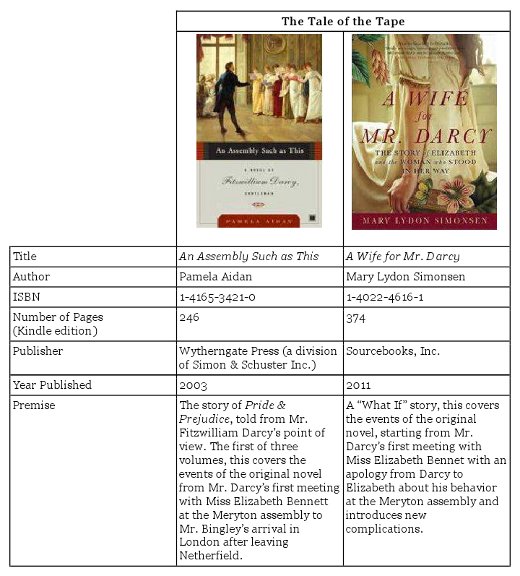
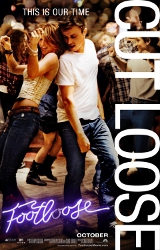 Footloose
Footloose

 [Editor’s Note: We’re trying something a little new here where more than one person writes a review of a given thing. Any and all feedback would be greatly appreciated. – TL]
[Editor’s Note: We’re trying something a little new here where more than one person writes a review of a given thing. Any and all feedback would be greatly appreciated. – TL]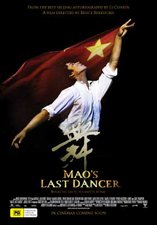 Mao’s Last Dancer
Mao’s Last Dancer Not exactly.
Not exactly.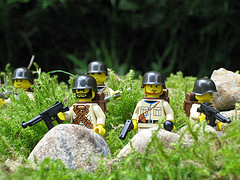
 If today you feel a wave of “WTF?” wash over you, check your nearest “Supernatural” fangirl for the source.
If today you feel a wave of “WTF?” wash over you, check your nearest “Supernatural” fangirl for the source.